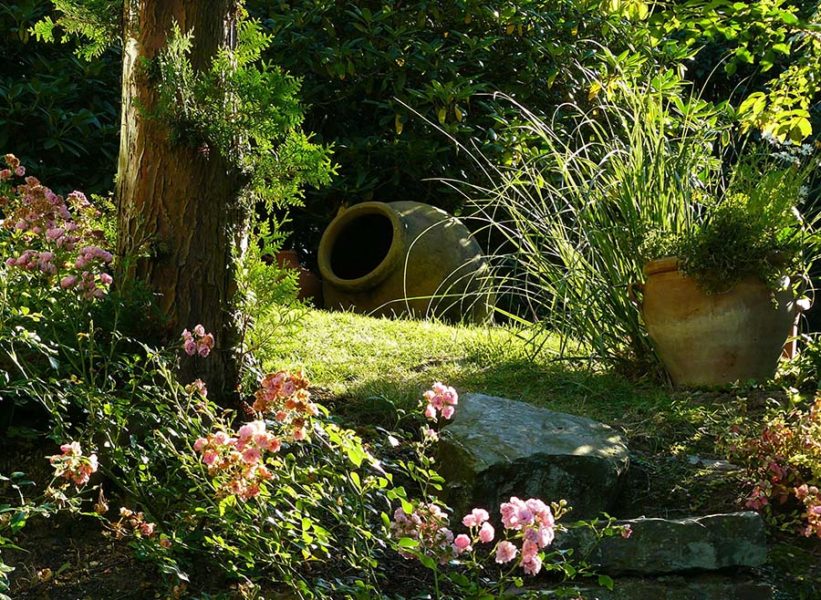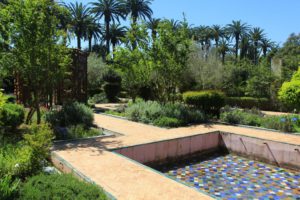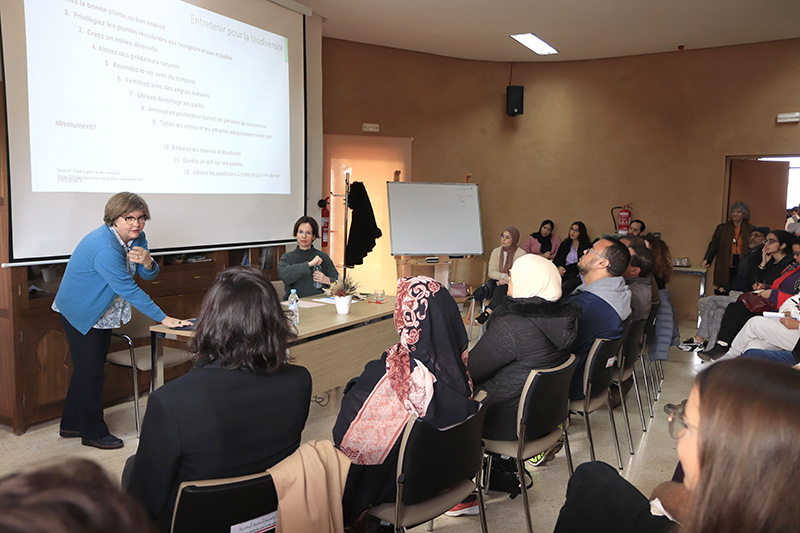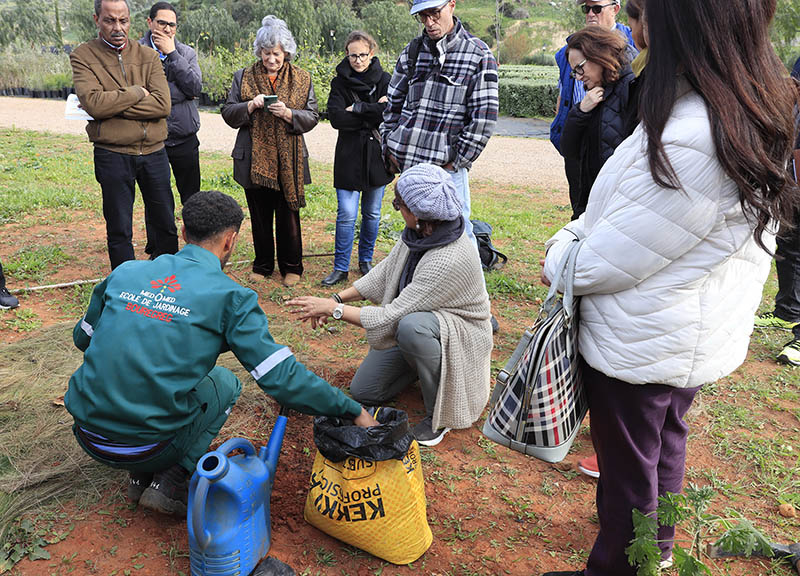On February16th, the Med-O-Med gardening school in Salé, Morocco, organised a seminar entitled “Towards regenerative landscaping”.
Morocco belongs to one of the regions most affected by drought, the result of rampant climate change. Although this winter rainfall and snowfall have been generous in the south, against all odds, water stress has been increasing across the country for years. Formerly arid regions are becoming desert-like at breakneck speed. The North Atlantic coast, where one of the main projects of the Med-O-Med network, a school for sustainable and social gardening, is located, is less affected by the lack of rainfall due to areas high humidity rate and its generous green mass: the Mamora cork oak forest.
The region of Rabat, Salé Kenitra is fertile, has a humid temperate climate (although increasingly similar to the continental one) and a long tradition of landscaping. This tradition goes back to Andalusian-Maghrebi, and, centuries later, to colonial gardening. In spite of this, its relevance has been lost over the years in favour of models that have little to do with the culture and ecological characteristics of the region. Qualified gardeners, on the other hand, are also conspicuous by their absence, despite the great demand for this profession in a city, Rabat, with large green spaces, both public and private. This was one of the main reasons, along with the desire to provide employment opportunities for disadvantaged young people, which led FUNCI, and in particular its President, Cherif Abderrahman Jah, to create this project.
In addition to being a centre for qualified vocational and work-linked training, it is a space for environmental awareness for the public and for cultural leisure.
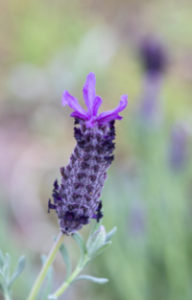 The seminar aimed to raise awareness among professionals in the sector, landscape gardeners, students and landscape technicians from local councils on the need to change the paradigm of gardening and landscaping in the region, as well as providing practical solutions and ideas to do so. The conservation of local biodiversity versus entirely exotic and water-demanding models and sustainable water management techniques, the creation of living soil and the interest of certain botanical species were the main topics discussed.
The seminar aimed to raise awareness among professionals in the sector, landscape gardeners, students and landscape technicians from local councils on the need to change the paradigm of gardening and landscaping in the region, as well as providing practical solutions and ideas to do so. The conservation of local biodiversity versus entirely exotic and water-demanding models and sustainable water management techniques, the creation of living soil and the interest of certain botanical species were the main topics discussed.
Landscape architects and botanists
The school was fortunate to have some of the best landscape architects in Morocco, all of them collaborators of the school, as well as the botanical director of the Majorelle garden in Marrakech, among others.
Carey Duncan, landscape architect and member of the AAPM (Association of Landscape Architects of Morocco) and the African Landscape Network (ALN), opened the floor. She gave a very informative general presentation on the importance of local biodiversity in landscaping. “What is biodiversity primarily? she asked, “the key to a healthy, quality environment”.
Duncan also went on to explain the positive impact it has on people’s physical and mental health. She spoke of soil quality and the importance of composting green waste to improve it. As an example, she gave the case of a US city where research has shown that green waste accumulated in dumpsters emits more greenhouse gases than all the cars in the city!
The seminar aimed to raise awareness among professionals in the sector, landscape gardeners, students and landscape technicians in local councils of the need to change the paradigm of gardening and landscaping.
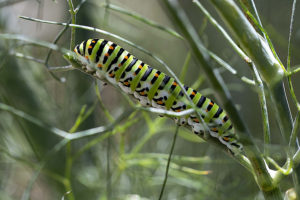 Duncan also insisted on the need not to prune trees indiscriminately, as, she explained, is the practice with palm trees in Rabat and Salé, as well as to avoid over-grassing and monocultures that exclude all wildlife. “Personally, I enjoy the ‘intruders’ that appear in the grasslands, so why mow them down so drastically and uproot them when they are a source of wealth? We need to rebalance the environment by the intervention of living things, animals and plants.”
Duncan also insisted on the need not to prune trees indiscriminately, as, she explained, is the practice with palm trees in Rabat and Salé, as well as to avoid over-grassing and monocultures that exclude all wildlife. “Personally, I enjoy the ‘intruders’ that appear in the grasslands, so why mow them down so drastically and uproot them when they are a source of wealth? We need to rebalance the environment by the intervention of living things, animals and plants.”
Maria Laraki, also a landscape architect and president of the AAPM, then gave a presentation entitled “A beautiful garden, yes, but a living garden, even better! She focused on water and its responsible management. She explained the need to think carefully before designing a garden, the future management of water, the choice of species and the need to create shade by planting trees so that the rest of the vegetation can develop with the least stress. She offered sustainable solutions for landscaping such as planting certain ground cover species instead of grass, choosing the most resistant and least water-intensive quality of grass for the creation of meadows, and the types of mineral or vegetable mulches to avoid soil mineralisation and water evaporation.
Laraki presented the traditional technique of the so-called “oyas”, a word that comes from the Spanish, consisting of pots of a certain porous clay, which, once buried in the soil next to the plants, allow them to be irrigated gradually and economically. “What is beautiful is not necessarily green”, he exclaimed, alluding to the dry gardens, “it is urgent to change the mentality about the ‘green’ city”. A view shared by the other speakers.
After a lively debate with the public and a coffee break on the terrace of the Azafrán restaurant, Marc Jeanson, botanical director of the famous Majorelle garden in Marrakech, continued the discussion. Landscape architect Mounia Bennani, who acted as moderator of the event, introduced Jeanson with a special mention because of “how rare and therefore valuable botanists are in Morocco”.
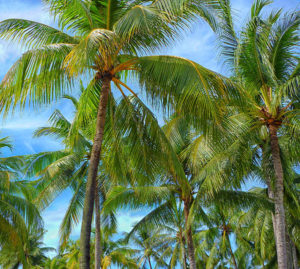 The botanist’s beautiful graphic and oral presentation “Palms, an immersion in an exceptional botanical family” aroused great admiration among the audience for the enormous variety of species of this plant throughout the world and their beauty. Jeanson insisted on the need to know the botanical species for landscaping and conservation. “You can’t conserve something you don’t know,” he said. He spoke of the age of palm trees, some of which can reach 35 to 40 years of age, and showed some of the most beautiful and unique of the 2,500 existing species. The botanist referred to the shape of their leaves: pinnate, double-pinnate, palmate and how certain species try to protect their single bud at all costs, which leads to the death of the plant if it is cut off during excessive pruning. He also referred to the characteristics and beauty of certain stems and some species that die after their single flowering. He delve into the most common palms in Morocco, from cultivars such as Phoenix dactylifera, to the Canary Island palm (Phoenix canariensis) and the abundant and valuable wild palmetto (Chamaerops humilis). He assured that the variety of palms is so extensive across the planet that “the collections of plants contained in ancient documents are the only source of concrete and reliable information”.
The botanist’s beautiful graphic and oral presentation “Palms, an immersion in an exceptional botanical family” aroused great admiration among the audience for the enormous variety of species of this plant throughout the world and their beauty. Jeanson insisted on the need to know the botanical species for landscaping and conservation. “You can’t conserve something you don’t know,” he said. He spoke of the age of palm trees, some of which can reach 35 to 40 years of age, and showed some of the most beautiful and unique of the 2,500 existing species. The botanist referred to the shape of their leaves: pinnate, double-pinnate, palmate and how certain species try to protect their single bud at all costs, which leads to the death of the plant if it is cut off during excessive pruning. He also referred to the characteristics and beauty of certain stems and some species that die after their single flowering. He delve into the most common palms in Morocco, from cultivars such as Phoenix dactylifera, to the Canary Island palm (Phoenix canariensis) and the abundant and valuable wild palmetto (Chamaerops humilis). He assured that the variety of palms is so extensive across the planet that “the collections of plants contained in ancient documents are the only source of concrete and reliable information”.
Endemisms and living soil
After lunch spoke Marrakech-based landscape architect Kevin Lelièvre, known for his landscaping with endemic Moroccan species. To talk about the design of green spaces with endemic plants, he presented the case of a large luxury hotel in Agadir facing the Atlantic, which had its back to the ocean because the dunes (which were destroyed for its construction) periodically invaded it and because the saltpetre did not allow the plantations to flourish.
“Local endemic plants are the only ones capable of resisting the current water stress and stabilising the sand: argan trees, Ziziphus, certain euphorbias, etc.”.
He explained how during the 100 days of confinement due to the recent pandemic crisis, the garden was left to its own devices and the dunes returned. When he proposed to the client to drastically reform the garden and even recreate a restitution of the dunes with endemic and indigenous species resistant to that ecosystem, the client screamed at him that it would not thrive. “But I am very stubborn,” said Lelièvre, “and I stuck to it; it was the only way to landscape this area, which is so poor in vegetation and diversity, and local endemic plants are the only ones capable of resisting the current water stress and stabilising the sand: argan trees, Ziziphus, certain euphorbias, etc. The problem with this type of species”, continued the landscape designer, “is that they are not easily found in nurseries and even less so in large quantities”, and in this sense he praised the initiative of the Med-O-Med gardening school with the creation of its nursery dedicated in large part to native and endemic trees and shrubs, “which has been a discovery for me”.
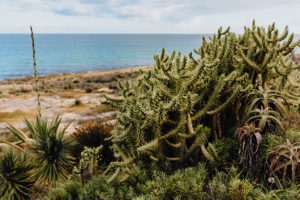 Lelièvre explained he was not a purist and that in his landscaping in arid areas, he mixes local species such as tamarix, agaves and Limonium with some exotic species well adapted to the environment, an opinion shared by all the speakers. He also stated that he sometimes uses grass, at the request of his clients, “but in no case kikuyu, but much more rustic varieties. There are some varieties, such as zoysia, which can even be watered with salt water! Besides”, he continued, “I never cut it and it looks very nice”.
Lelièvre explained he was not a purist and that in his landscaping in arid areas, he mixes local species such as tamarix, agaves and Limonium with some exotic species well adapted to the environment, an opinion shared by all the speakers. He also stated that he sometimes uses grass, at the request of his clients, “but in no case kikuyu, but much more rustic varieties. There are some varieties, such as zoysia, which can even be watered with salt water! Besides”, he continued, “I never cut it and it looks very nice”.
In addition, Kevin Lelièvre explained that, in order to garden with this type of slower-growing, humble-looking species, it is necessary to warn the client and to be patient, as the initial appearance is poor. After a few months, however, the garden becomes beautiful and, at the same time, sustainable.
“The living soil is an ecosystem in itself, monoculture kills the soil. The rhizosphere (the richest part of the soil, in contact with the roots) is a living ecosystem in which countless little hands work together”.
The seminar was closed by Zineb Benrahmoune-Idrissi with an excellent theoretical, but above all practical, workshop on the creation of living soil. Benrahmoune-Idrissi is a former research professor at the National School of Forestry Engineers and one of the pioneers of permaculture in Morocco, now a producer and trainer in syntropic agriculture.
She explained that “living soil is an ecosystem in itself, monoculture kills the soil. The rhizosphere (the richest part of the soil, in contact with the roots) is a living ecosystem in which countless little hands work together”. To maintain it, he explained, it is necessary to avoid tillage and compaction, and soil must be built up with layers of organic matter that breathes. A diversity of trees, shrubs and perennials should be provided to create shade and shelter for each other. Like the other speakers, he also insisted on the need for a good natural mulch to prevent evaporation and encourage life. Finally, and before moving on to the park for a demonstration of living soil and planting, Zineb Benrahmoune-Idrissi insisted on the importance of agroforestry, and on the need to change the paradigm of contemporary gardens: “Why should we want a green garden even in the middle of summer?”
The live demonstration, in one of the plots with the worst soil in the school park, was highly pedagogical. Zineb, assisted by a couple of apprentices, sowed, added vegetable compost, sheep manure and straw and planted some species from the school’s nursery: argan, mastic, rockrose… a short but great master class, as is her custom.
We hope thaht the seminar bears fruit after the sowing work and the germination of ideas and concepts.
Inés Eléxpuru, FUNCI
This post is available in: English Español

